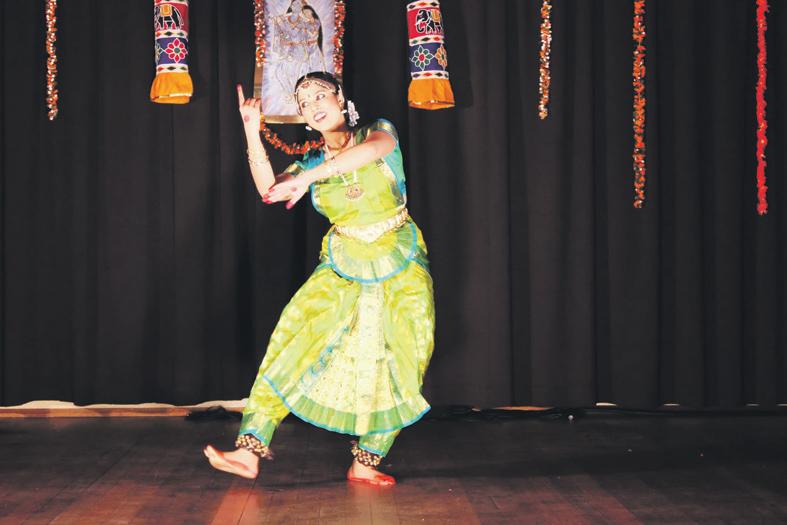
14 minute read
Bhakti through dance and song
from 2013-09 Sydney (2)
by Indian Link
Simple, yet powerful artistic classical performances evoke
BY DINISH R AMANAN
The Global Organisation for Divinity (GOD)
Australia, staged an evening of dance and music recently at the Dundas community centre, in connection with the Krishna Janmashtami celebrations. The Master of Ceremony mentioned in her introduction, the many facets of Lord Krishna’s personality and thanked the artists for coming forward to perform at the event. She observed that in order to learn the art with devotion, and to offer it back to the Lord is a great form of prayer in itself.
The initial part of the evening was an hour-long Bharathanatyam performance by Shruti Sharma. With great elegance and poise, Shruti brought out her phenomenal talent in this classical dance. Her swift and dexterous movements and fantastic facial expressions demonstrated perfectly that Bharathanatyam is indeed music in visual form.
Shruti expressed the meaning of the songs through hand gestures and eye movements, and the rhythm with her feet. One could clearly get a whiff of the essence of natya shastra, Yato hastha, thatho dhrushti, mana, bhava and rasa in that sequence. What better way to transport the audience to a state of mental devotion for an entire hour! The songs chosen by Shruti for the dance were very meaningful, simple to follow and perfect examples of simplicity that is Bhakthi. Starting with Sri Muralidhara Swamiji’s composition Bhagyamae Bhagyam, it included Sri Ramachandra kripalu, Odi odi olivadhu, Ananda thandavam, Chaliye kunjanamo and the thillana All these songs brought out in an artistic way, the efficacy of singing the divine names of the Lord.
Shruti’s teacher Hamsa Venkat choreographed her dances and the rhythmic articulations bore the stamp of excellence for which Venkat is renowned.
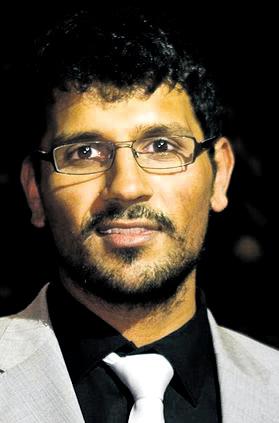
The second part of the evening belonged entirely to Mrs Laksmi Abhishek and her group. Kranthi Kiran Mudigonda was on the violin, Sivakumar Sethupathy on mridangam and Hari Shankar on kanjira. For about 90 minutes, the artistes held the audience of 150-plus completely spellbound.

With Swagatham Krishna, Lakshmi made a glorious start invoking a sense of surrendering our ego to the Lord, with her melodious voice. This was followed by Sri Muralidhara Swamiji’s kirtan, Manobalam yenakku arulvai which was sung with a great depth of emotion. As the concert progressed, it quickly became a great feast to the ears and minds rendered by such an excellent blend of sruti, swara, raga and tala The melody of the violin and the rhythm of the mridangam and kanjira were of the highest order. The songs Varadharajan upasmahae, Kanna, kaatharul, Pachai ma meni, Baro Krishnaiah and the finale Vittala were not only great musical treats sung with such melody, but they conveyed very deep thoughts and glorified bhakti in a very emotional way.
The secretary of GOD Australia felicitated the artistes for their enthusiastic participation, and expressed his heartfelt appreciation for their excellent performances. In organising the event, GOD Australia desired it to be not merely a cultural event, but aimed to convey the point that bhakti, especially through singing the divine names, is very relevant and important in modern times. The artists of the night brought out this point in such a simple, elegant and powerful way that the audience would never forget, ever!

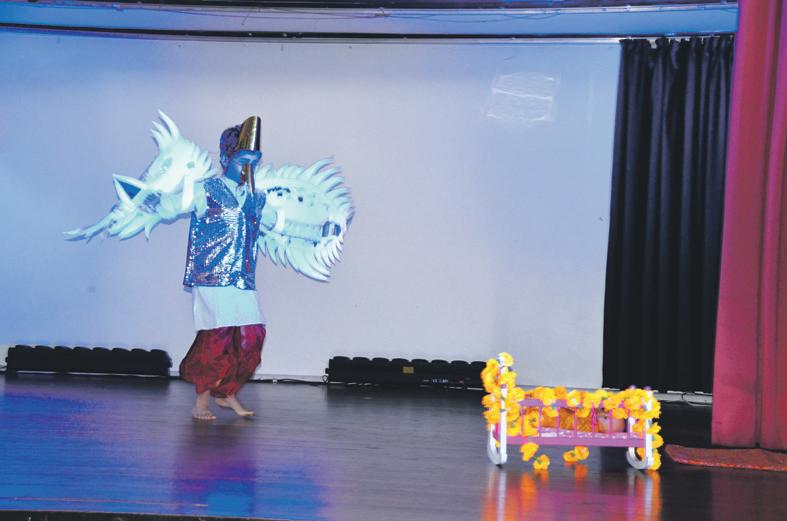



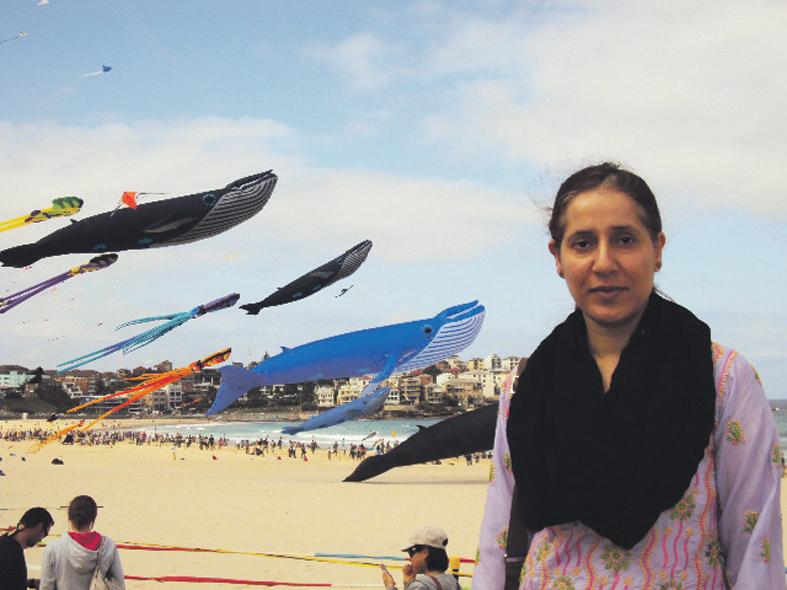




A watery end for the beloved elephant-headed Hindu god Ganesha marks the conclusion of the Ganesh Chaturthi festival celebrations in Hyderabad, Sept. 14, 2013. The festival is celebrated to mark the birth of Ganesha, the Hindu god of wisdom, prosperity and good fortune

In politics to make the poor dream big, says Rahul Accusing opposition parties like the BJP of pursuing pro-rich policies, Congress vice president Rahul Gandhi recently said his mission in politics was to make the poor dream big.
Addressing a huge rally in Baran in Rajasthan after presiding over functions aimed at improving irrigation and power supply, Gandhi sought to identify the country’s oldest party with the poor.
“We want the poorest of poor to be able to realise their dreams. We want women should be able to realise their dreams. Otherwise, there is no interest in politics for us,” he said to applause. This was his second rally in Rajasthan in seven days.
In his about 20-minute speech, Gandhi took a veiled dig at Bharatiya Janata Party (BJP) and its prime ministerial candidate Narendra Modi.
He said people come and make tall claims but the Congress delivers.
Gandhi stressed that the poor and women were the power of the country.
“If the country moves forward, it will be on the basis of your dreams. If we do not allow you to see dreams, the country cannot go forward,” he said. “Our politics is politics of your dreams,” he said.
He repeatedly referred to welfare legislations passed by the UPA government including on food security, rural employment guarantee and land acquisition.
The opposition, he said, were creating hurdles in their passage.
He said the opposition agreed with the Congress on the need to build infrastructure, including roads, bridges, railway lines and power plants, but not on the party’s concern for the poor.
“They (opposition) say well-placed people should walk on these roads, should board planes while the common man goes hungry and keeps looking at swanky cars. We say the biggest dream should be seen by the poor,” he said.
The son of Congress president Sonia Gandhi contended that the reasons behind poverty was not unemployment but frequent health problems and diseases.
Noting that the Congress government in Rajasthan was giving free medicines to the poor, he said the scheme will be replicated in the entire country.
Gandhi said India was a country of young but most were poor.
“They have a lot of dreams. If they want to find employment, want to start a business, the government needs to hold their hand,” he said.
Gandhi did not directly refer to Modi, but Rajasthan Congress chief Chandrabhan called the Gujarat chief minister “a specialist in riots”.
Chandrabhan said there were no differences between Modi and BJP veteran L.K. Advani. Both, he said, were “communal”.
Gandhi earlier presided over functions to lay the foundation stone of the Parwan River Dam Project and Super Critical Power Plant in Chhabra and three units of the Chhabra Plant and a sub-critical unit at Kalisindh.
The Krishi Upaj Mandi ground, venue of Gandhi’s rally, was brimming with people who had come from different parts of Baran, Jhalawar, Kota and even from areas in neighbouring Madhya Pradesh.
Many wore caps bearing photographs of the Gandhis.
Gandhi was accompanied by Chief Minister Ashok Gehlot, former union minister C.P. Joshi, Corporate Affairs Minister Sachin Pilot and several other Congress leaders.
Mandate to improve India ties: Sharif
Prime Minister Nawaz Sharif has said that Pakistanis have given him the mandate to improve relations with India, a newspaper reported recently.
“I have always given high priority to good relations with India for the sake of durable peace in the region,” The Nation quoted Sharif as telling Turkish Radio and Television (TRT) network in Ankara
“We are keen to have a comprehensive dialogue with India for the resolution of all issues including the issue of Jammu and Kashmir,” said Sharif, who took office in June.
Sharif was in Turkey on a three-day official visit.
Sharif said he had started the peace process with India when then Indian prime minister Atal Bihari Vajpayee visited Lahore in 1999.
He said the two countries were then very close to finding a settlement to the Kashmir dispute.
Sharif said his government wanted stable ties with all countries, especially the neighbouring ones.
“For the effective pursuit of our socioeconomic agenda, good relations with all our neighbours are essential and a priority for my government”.
“Combating terrorism and extremism is one of the top priorities of my government. Terrorism and extremism are now a global menace,” he added. “No country in the world is unaffected by it. Militancy and extremism pose a grave challenge to Pakistan’s progress and development”.
Turkish President Abdullah Gul Tuesday conferred his country’s highest civilian award Jumhuriyet Nishan on Sharif.
India hikes import duty on gold jewellery to 15%
India recently hiked the import duty on gold jewellery to 15% in a bid to protect domestic industry and curb the precious metal’s imports, a key reason for the country’s high trade and current account deficits.
“Import duty on gold imports is increased to 15% from the earlier rate of 10%,” the finance ministry said in a statement. The concerned department had issued the notification and the new rate became application with immediate effect.
“As part of measures to contain the current account deficit, the customs duty on gold has been revised upwards periodically in the past two years,” the finance ministry said.
The last revision was done August 13, when the duty was hiked to 10% from 8%. Prior to January 17, 2012, the import duty on standard gold (of 99.5 percent purity and above) was Rs.300 per 10 grams.
The duty was raised to two percent from January 17, 2012. Thereafter, it was raised to 4% in the Budget 2012-13. The duty was further raised to 6% from January 21, 2013 and to 8% from June 5, 2013.
Cash transfers boost women’s health, inclusion in Odisha
Mukta Mallick, a resident of Babada village in Boudh district, about 270 km from the state capital Bhubaneswar, continued to work as a daily wager after the birth of her first child. It came therefore as a blessing when, before the birth of her second child, she received Rs.5,000 in four instalments. She not only gave birth to a healthy baby girl but also obtained the necessary health services for herself and the baby. “It was a great help. I also learnt how to operate a bank account,” a proud Mallick, 36, said.
A conditional cash transfer scheme launched in Odisha two years ago has promoted the financial inclusion of thousands of women, except those who have central or state government jobs, besides helping them improve their health and that of their children, officials and beneficiaries said.
“This scheme has been well received by the public and the beneficiaries. The awareness about this scheme is also quite high,” said S. Aswathy, a director at the state’s women and child development department which implements it.
The Odisha government rolled out its Mamata (literally motherly love) Scheme in September 2011 to provide monetary support every year to poor women, especially those who are forced to continue working during pregnancy and lactation. Some Rs.3.5 billion has so far been disbursed under this scheme, for which some one million women have registered.
97% of the beneficiaries, who are helped to open zero balance savings accounts in the nearby banks, belong to the rural and tribal areas. District level officials involved in the work said this was the first time that direct electronic transfer of funds to the accounts of the beneficiaries has been attempted on such a large scale in the state in any social sector programme.
Initially there was a challenge because of availability of banks and the women were not familiar with banking operations. Local officials facilitated their travel to banks and in some places bank officials conducted camps.
Woman aged above 19 are eligible for the benefit for the first two live births after opening a bank account, registering the pregnancy with local authorities, going for regular antenatal check-ups and regularly consuming medicines and vitamin supplements.
The last instalment is given after the immunisation schedules are over and the infant completes nine months.
Nearly half a million beneficiaries have successfully exited the scheme with all four tranches. Most of them, however, continue to operate their bank accounts, an official said.
Odisha is home to about 42 million people. Half of them are poor and mostly live in rural areas. The state once had the dubious distinction of having the country’s second highest infant mortality rate of 65 per 1,000 births after Madhya Pradesh’s 67 in 2009. This has now been brought down to 57. The maternal mortality rate per 100,000 live births is 237 against the national average of 212.
The state has yet to evaluate the impact of the scheme but many involved in its implementation feel it has helped combat infant and maternal mortality.
Three Indian-Americans among
America’s
400 richest Three Indian-Americans figure among America’s 400 richest people with Microsoft co-founder Bill Gates retaining the top spot on the Forbes list for the twentieth straight year, at $72 billion.
Up $6 billion from 2012, Gates is once again the world’s richest person, having passed Mexico’s Carlos Slim in May.
Topping the Indian-American list was Florida outsourcer Bharat Desai & family with a net worth of $2.2 billion in the 252nd position. He was followed California software manufacturer Romesh T Wadhwani with a net worth of 2.1 billion. California venture capitalist Vinod Khosla was ranked 352 with a net worth of $1.5 billion
Investor Warren Buffett, the second richest is the biggest dollar gainer this year at $58.5 billion, up $12.5 billion from last year.
Oracle co-founder Larry Ellison at number three, worth $41 billion, is the same as last year; he is the only one in the Top 10 who did not add to his fortune.
Facebook founder Mark Zuckerberg was the second biggest gainer at $9.6 billion.
He returns to the Top 20 (number 20) at $19 billion after dropping to 36th position last year.
The combined wealth of the Forbes’ 2013 ranking of the richest people in America is $2 trillion, up from $1.7 trillion in 2012 and the highest ever, due in part to the strength of both the US stock and real estate markets.
The average net worth of a Forbes 400 member is a staggering $5 billion, the highest to date, up from $4.2 billion last year. Net worth increased for 314 members, and decreased for 30 members.
Racist tweets dog IndianAmerican Miss America
Moments after making history as the first Indian American to be crowned Miss America, the 24-year-old Miss New York Nina Davuluri faced a barrage of racist tweets on the internet.
“If you’re #Miss America, you should have to be American,” said one as cited by CNN.
“WHEN WILL A WHITE WOMAN WIN #MISSAMERICA? Ever??!!” screamed another.
Davuluri is also the first beauty queen of Indian descent to serve as Miss New York.
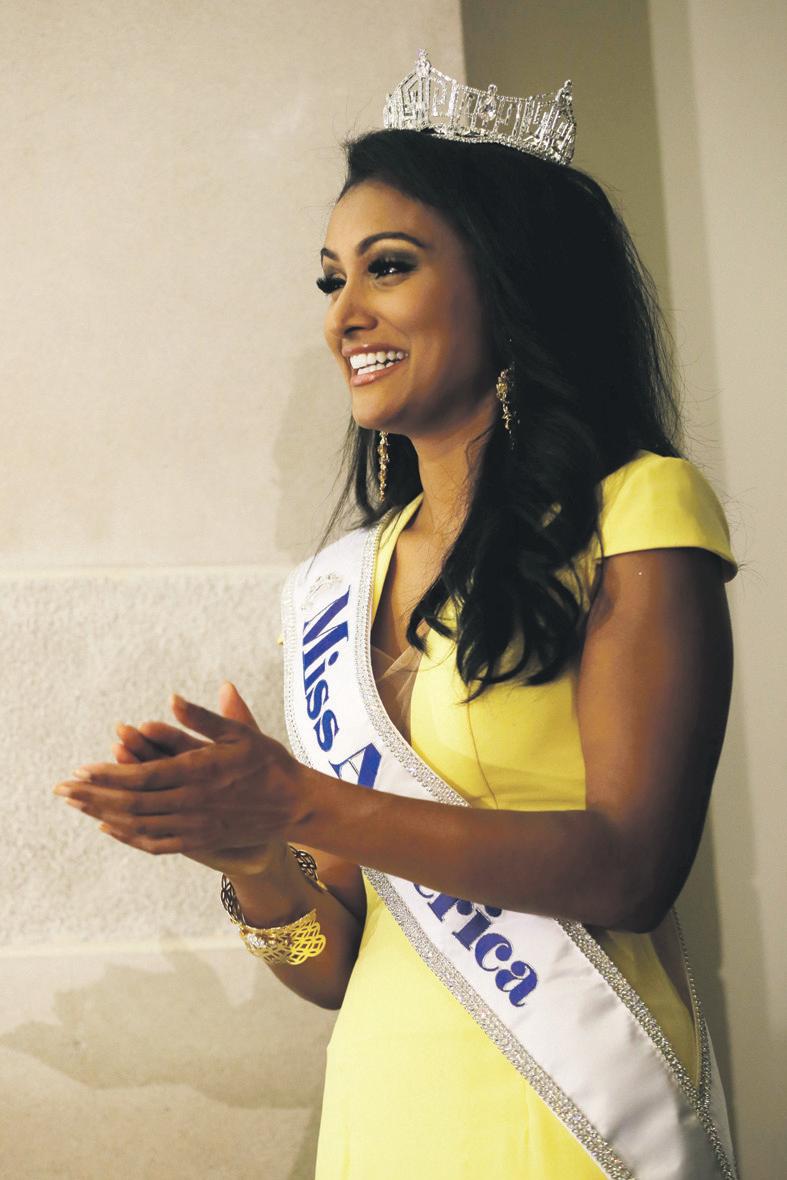
But instead of focusing on how a New Yorker had won the beauty pageant for the second consecutive year, the tweets were about Davuluri’s heritage, CNN noted.
“Well, they just picked a Muslim for Miss America. That must’ve made Obama happy. Maybe he had a vote,” vented one person, cited by CNN who pointed out that Davuluri was not a Muslim and the president did not have a vote.
Davuluri herself brushed aside the negative comments saying, “I have to rise above that”.
“I always viewed myself as first and foremost American,” she said.
New website to track Delhi’s missing children
The Zonal Integrated Police Network (ZIPNET) would be closed soon, as a new website to track Delhi’s missing children has been launched, an official from the department of Women and Child Development (WCD) said recently.
“ZIPNET will now be closed and the national website to track children (www. trackthemissingchild.gov.in) has been launched and will work in a full-fledged manner, so that there is integrated detail to track missing children,” said Premoday
Khakha, assistant director, Integrated Child Protection Scheme (ICPS).
He was speaking at the public hearing and consultation event organised by nongovernmental organisations (NGOs) between the parents of missing children and stakeholders.
“The figures of missing children collected through the Right to Information (RTI), ZIPNET and National Crime Records Bureau (NCRB) are different, which shows lack of convergence between child protection agencies, which is a matter of serious concern for the implementation of child rights in the state,” said Soha Moitra, regional director, Child Rights and You (CRY).
Parents of missing children from across Delhi presented their case before the panel, comprising National Commission for Protection of Child Rights (NCPCR), State Commission for Protection of Child Rights, Integrated Child Protection Scheme, Delhi, and officials from Delhi Police, who promised strict action.
“As soon as the child goes missing, all relevant child protection stakeholders should be alerted for fast-tracking the case,” Nina Nayak, member, NCPCR, said, underlining the need for convergence between different authorities in the state.
As per figures corroborated by CRY and Alliance for People’s Rights, between January 2012 and December 31, 2012, around 4,364 children went missing in Delhi.
Measuring earth’s circumference using Qutub Minar’s shadow
An organisation working for the development of science and astronomy will conduct a project to measure the circumference of earth, using the Qutub Minar’s shadow on the autumnal equinox recently.
Under this project, SPACE (Science Popularisation Association of Communicators and Educators) will help volunteers take actual measurements of the Qutub Minar’s shadows made by the sun to measure the circumference of earth.
Autumn equinox is when the night and day are of same length and the sun crosses over the earth’s equator, marking the beginning of autumn.
SPACE has been conducting this project previously at various historical sites like Jantar Mantar and using the giant sundial constructed at Barapullah during the Commonwealth Games.
“With the help of this project, SPACE has highlighted that such Indian monuments can be used as tools to demonstrate and get the common man interested in science. It is a showcase for proving that science can be best learnt by doing,” said SPACE president C.B. Devgun.
“In this experiment, students have been able to calculate the circumference of earth to an accuracy of 99%,” he added.
Japan extends Rs.4,553 crore loan for Mumbai Metro-3
The stage is set for constructing the 33.5km long, fully underground Mumbai Metro-3 line with Japanese finance, the first instalment which is to the tune of 71,000 million yen (Rs.4,553 crore), an official said recently in Mumbai.
An agreement was signed between Japan International Cooperation Agency (JICA) and the Indian government in New Delhi, where JICA has pledged the first tranche of the 1.40 percent, 30-year loan for the mega-infrastructure project, according to an official of Mumbai Metropolitan Region Development Authority (MMRDA).
The Mumbai Metro-3, one of the biggest in the entire planned network, will be the city’s first fully underground stretch, from south Mumbai’s tip Colaba to Bandra to Santacruz Airport to SEEPZ in Andheri east.
The JICA agreement follows a commitment by Japan vide Organisation for Economic Co-Operation and Development for the first loan instalment signed March 25 this year.
The Japanese loan, which would comprise 57.2% of the total estimated project cost of Rs.23,136 crore, would be spent on constructing the line, along with tunnels running below the sea creeks, railway stations and allied facilities, rolling stock, system component and consulting services. With this agreement, the executive agency, Mumbai Metro Rail Corporation will now be a joint venture company of the state and central government.
As per present plans, the project will commence this year itself and will be completed in 2020, the MMRDA official said.
The other finance will come from the central and state equity of 10.4% each, sub-debt by the central government (4.4%), sub-debt by the state (7%), property development and impact fee (4.3%), stakeholder contribution from the Mumbai International Airport Ltd. (3.4%) and
MMRDA grant/aside funding (2.9%).
The project will give a boost to the public transport network in the country’s financial capital where the existing roads and railway networks are severely congested owing to lack of space for expansion.
“This is a very crucial project and has got the required impetus. It will afford Mumbai the required mobility and bring back the aura it has almost lost in recent times,” MMRDA Metropolitan Commissioner U.P.S. Madan said on the occasion.
“The JICA loan to this project will go a long way in in addressing the major problem of urban congestion in Mumbai where people spent endless hours on roads and local trains are overloaded. On completion, it will considerably help improve the quality of life of the common Mumbaikar,” said JICA chief representative Shinya Ejima.
The Mumbai Metro-3 will have 26 underground stations starting from Cuffe Parade and passing through Worli, Bandra, the domestic and international airports and finally terminating at SEEPZ near Jogeshwari.
It will also provide passenger interchange facilities with Central Railway at Chhatrapati Shivaji Terminus and Western Railway at Churchgate, Mumbai Central and Mahalaxmi, and the upcoming Metro-1 at Marol Naka, Metro-2 at Bandra-Kurla Complex and Monorail at Mahalaxmi, the intention being to provide seamless travel across the city. IANS










